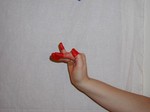Udvṛtta
Nṛttahastas - Dance hands (single and combined)
Descriptions and Meanings
9:179
(b) Two Hamsapaksa hands are waved like Tiilavrnta (palm leaf fan). This should be known as Udvṛtta or Tālavṛntaka.
9:175
Udvṛtta—the two Haṃsapakṣa hands waved like a palm-leaf (fan). Its alternative name is the Tālavṛnta (palm-leaf).
26:72
The two Haṁsapaksa hands, turned like a palm-leaf fan, should be known as Udvṛtta or Tālavṛntaka.
No verse annotation
Udvṛtta (asunder): one Hamsa-paksa hand held face down-wards and one face upwards. Patron deity Vasistha.
No verse annotation:
modesty, simile, torment, thorns etc., difference, consideration.

Haṁsapaksha - No verse annotation

Haṁsapaksha - No verse annotation
Not included elsewhere
8:528-529
When one Hamsapaksha hasta is held face downwards and the other face upwards, simultaneously, it is Udwṛtta hasta.
8:528-529:
This hasta is used to denote the following : modesty, simile, torment, thorns etc., sorrow, fear, consideration.
4:1239-1240
Udvṛtta: The two hands which are in Haṁsapaksha Hasta are waved like palm-leaf fans in front of the chest.
7:84
Udvrtta: When both the hands face each other forming the hansa paksha hasta, it is udvrtta.
2:239
One executes the vyāvartana while the other parivartana, simultaneously. This is done as the hands move upwards and these hands are udvṛtta hastas.
No image available
Vyāvartana - 2:209 No image available
Parivartitam - 2:210-211
Not included elsewhere
:872
If the two Hamsapaksas are placed in front of the heart, as if preparing to play on two talas (cymbals), it is Udvrtta hasta.
7:112
If two haṁsapakṣas, facing away from each other are held at the chest in front it is udvṛtta.
3:478-479
When haṁsapaksha hands are moved in the same way with one hand turned up and lowered and the other turned downwards off the chest, it is known as udvrtta. Some call it talavrnta
3:478-479:
it is used to indicate a palm-leaf fan.
3:478-479
Others say that when two haṁsapaksha hands facing forward are moved inwards and outwards it is udvṛtta
3:478-479:
it is used to indicate victory.


![If the udvṛtta [saṁyutahasta] are held obliquely at the sides, it is recognised to be talamukha.](https://lakshmiammanswebsite-live-00aaba1203334-2b2b45f.divio-media.com/filer_public_thumbnails/filer_public/14/5e/145e32fe-b491-41f2-8ad3-baef67090e77/talamukha.jpeg__50x50_q90_subsampling-2.jpg) Talamukha
Talamukha